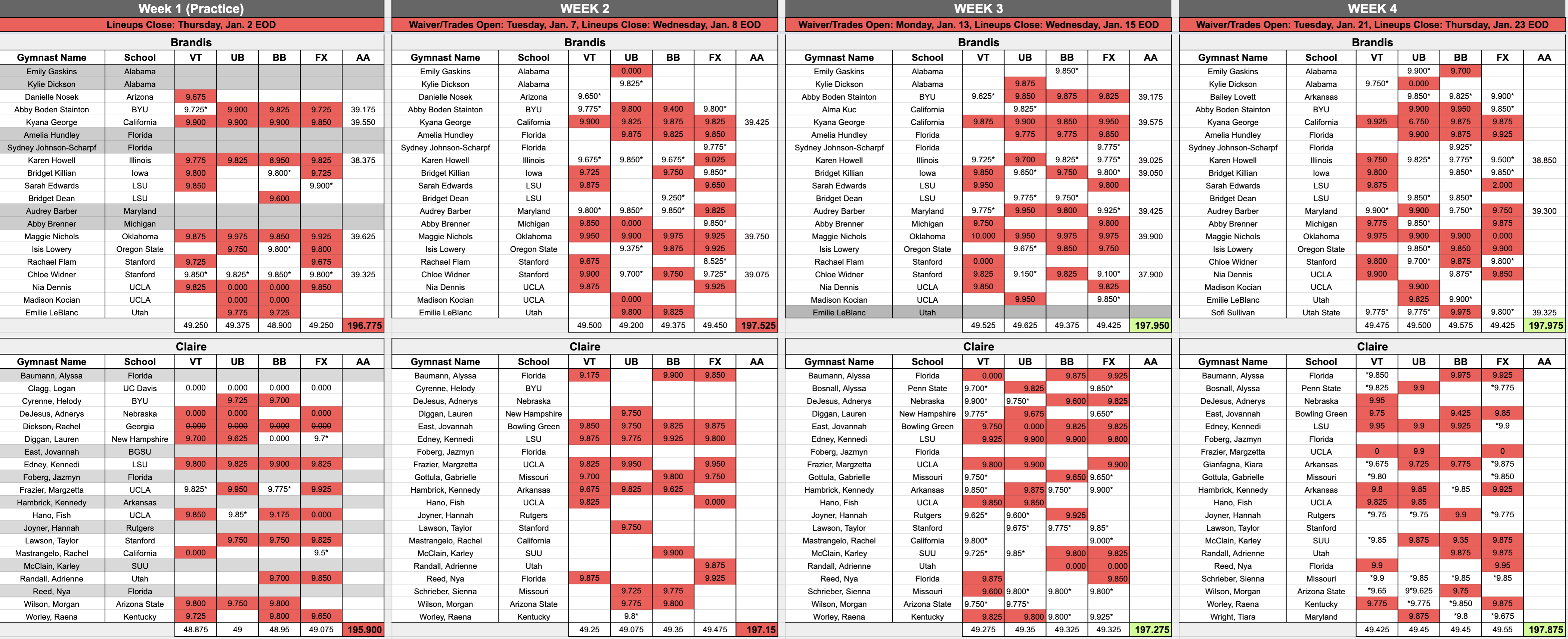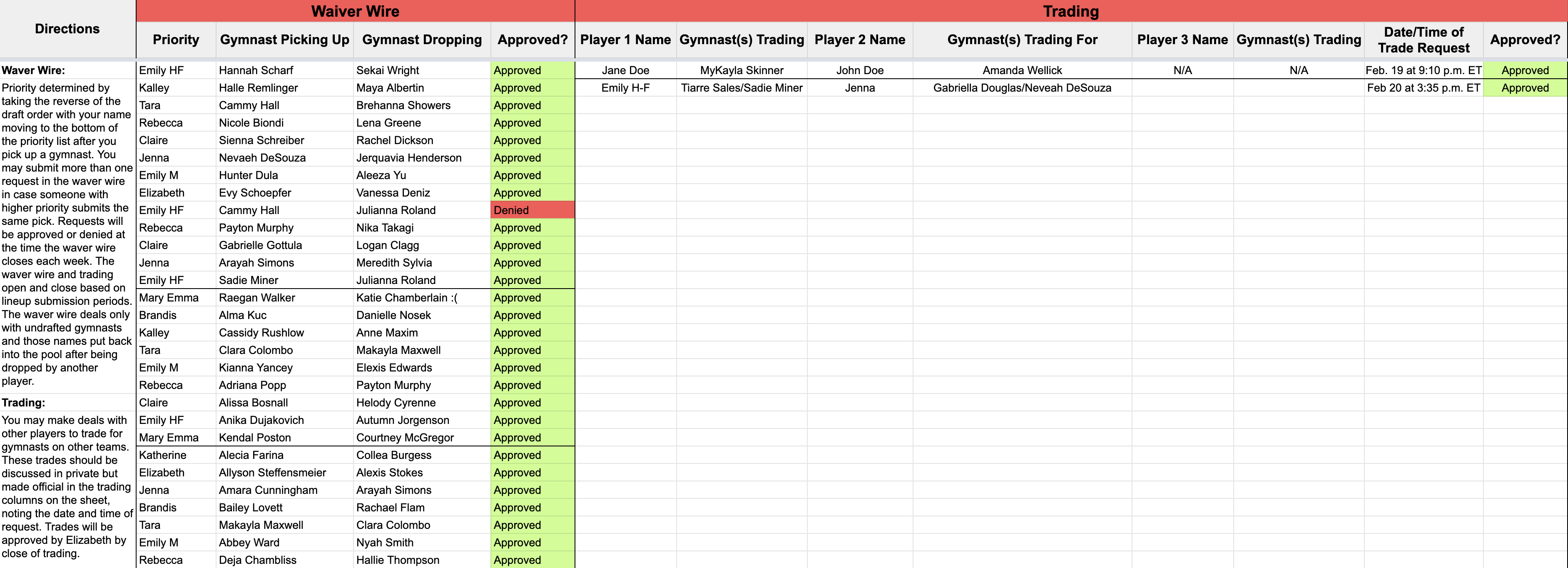The official College Fantasy Gymnastics game will not be played this season—who can blame Kristen and the other organizers for taking the year off with all the uncertainty surrounding the sport.
Hi everyone! We wanted to share an update on Fantasy Gym for this season. Unfortunately, due to the lead time required to prep for and launch the season, and the uncertainty around the structure and schedule for this season, we have decided not to run Fantasy Gym for this year.
— Fantasy Gymnastics (@FantasyGym) December 14, 2020
If you just can’t stand the thought of not playing in 2021, or don’t want the uncertainty it might bring, don’t worry! We’re providing you with instructions, templates and anything else you might need to play your own game from home, based off what the staff at College Gym News typically does for its internal game each year.
Step 1: Find Friends or Fellow Fans
Whether it’s club teammates or you recruit your closest gymternet friends, you’ll need to find at least five or so friends to play along with you. Reach out on social media or ask your friends in real life to join you for some fantasy gym fun in 2021. The game technically works with as little as two people but is most fun when played with 10-15. Can’t find anyone to play with? Try reaching out to the gymternet at large on Twitter, and there’s bound to be a game you could join. Use the #FantasyGym hashtag to be seen by the right people.
After you have your group of players, designate a commissioner who will be in charge of running the draft and keeping track of trading and the standings each week.
If you’re still searching for a private league to join or gymternet friends to play with, click on this link and add your name to the spreadsheet to let others know you’re looking.
Step 2: Set up the Draft
One pro to playing a “manual” game of fantasy gym is you can have a real draft, which can be much more exciting than the automatic way you’re give a team when playing the CFG version. The commissioner will determine the draft order. At College Gym News, we use Random.org to generate the ordered list of names. Simply input each player’s name and the site will spit out the order in which the players will pick on draft night. Let your players know the order ahead of time as they could use a different strategy knowing they’re picking first or last.
Once you have the draft order, you need to schedule draft night! Choose a time when the majority of your players are available to draft. The CGN staff is spread out across four-plus different time zones, so it’s a little tricky, but we end up doing it on a weeknight around 8 p.m. ET. If someone can’t make it to the selected date and time, don’t fret! They can designate another player to be in charge of choosing their gymnasts—either by providing a list like in the CFG game or by giving their proxy free reign to choose gymnasts as they wish. What you do for players absent from the draft is up to you. At CGN we use these same proxy rules if someone needs to join late or leave early.

Step 3: Draft the Teams
It’s draft night! Everyone has been hard at work for days or even weeks to prepare their stats and list of gymnasts they hope to add to their team for the 2021 season, and the excitement level is high. Drafting real-time can be fun but also stressful, so make sure to stay alert and don’t miss your turn! Here’s how it’ll work:
- Copy this draft template and fill it in based on your number of players, player names and times. We typically allot one minute per player to make their selection, which works out to be about four hours of drafting with a 10 minute break for 11 players, but you can designate as much time as you want per player per round. You could also split the draft into two nights to better accommodate players. This year, we’re potentially planning to draft more than 20 gymnasts per team to help any potential all-conference bye weeks that may occur due to postponements or COVID-positive preparations.
- Once your spreadsheet is set up, we also suggest setting up a way for all players to chat during the draft. At the very least the commissioner needs a way to indicate to players when it’s their turn to select or remind them when time is almost up. However, rather than waiting around for your turn, it’s fun to chat with fellow players about selections, joke around about someone stealing the gymnast you were about to pick or simply chat with fellow gym fans as the draft occurs. You could even video chat if you’re playing with people you know well. We like to chat on Slack during our draft, and some staffers even set up a Google Hangout.
- Once the draft begins, the commissioner is in charge of ensuring things run smoothly and everyone stays on track. When it’s your turn, decide on the gymnast you want (making sure no one else has already picked them). Then, put your pick under your name in the appropriate round’s slot on the spreadsheet. Once you’ve confirmed your choice, highlight the cell in green to lock in the selection. After your minute (or whatever time allotment your group chooses) is up, your cell will automatically be turned green. If you miss your turn, you will be skipped and will have to make your pick either at the end of the round you missed, at the end of the night or at the end of the draft.

Step 4: Set the Lineups
Using this template, have each player set up their table with the names of the gymnasts on their team. Highlight cells to indicate which eight gymnasts are in the lineup on each event each week. At CGN, each player is responsible for inputting scores for their own team themselves, and accuracy is on the honor system. If any gymnast competed more than once in a weekend, your group can decide before the season stars whether you want to average scores, like the official CFG game does, or take the highest score of the weekend, which is what we do at CGN. Don’t forget to let players know ahead of time when lineups are due as well! We typically set our deadline for the night before the first night of competition in a given week.

Step 5: Trading and the Waver Wire
Another perk of doing your own fantasy gym game is you have much more flexibility to do real trades between players and set up a true waver wire like in other fantasy sports games. If you’re not familiar with the concept, it’s not too difficult. A waver wire essentially is a priority list for players to pick up and drop gymnasts each week. Rather than it being first come first serve, there is an order from which players get “first dibs” at selecting which gymnasts they want to add to their roster.
In the past, the CGN staff has used the following rules for its internal fantasy game: Priority is determined by taking the reverse of the draft order with names moving to the bottom of the priority list after that player picks up a gymnast. Players may submit more than one request in the waver wire in case someone with higher priority submits the same pick. Requests will be approved or denied at the time the waver wire closes each week, which is typically a day before lineups close to give players time to set lineups with their new additions. The waver wire deals only with undrafted gymnasts and those names put back into the pool after being dropped by another player.
Trading occurs between two (or more) players and is a swap in more of the traditional sense of the word than how it is utilized in the official CFG game. The commissioner of your game is in charge of approving or denying trades. You may make deals with other players to trade for gymnasts on other teams. These trades should be discussed in private but made official in the trading columns on the spreadsheet, noting the date and time of request. CGN doesn’t utilize trades very much, but they can still be useful if one player has a surplus of vaulters but desperately needs gymnasts who excel at bars.
For an example of our trade and waver wire spreadsheet, visit this template.

Step 6: Standings
Calculate weekly and cumulative average standings each week to determine which players are in the lead. You can also decide within your group how you want to determine standings after a certain amount of weeks. At CGN, we drop the high and the low and average the remaining totals. We also have a practice week to start. You can choose to do whatever method works best for you and your players, including a strict average, dropping more than one high or low or anything else you can think of.
Bonus Tips
Because 2021 is expected to be a weird year, with more byes than normal and the potential for big chunks of gymnasts not competing at the last minute, think ahead about contingencies you might put in place to counterbalance these occurrences. At CGN, we’re planning to have each player draft teams of 25 rather than the typical 20, and when setting lineups, we’ll also select three “subs” for each event that are allowed to be slotted in should a gymnast or her team not compete due to COVID. While this is one example, there are plenty of ways to think ahead for the unusual circumstances that are likely to arise. The good news is, with a smaller, internal game, you can make whatever rules you want!
Overall, playing your own fantasy gymnastics game isn’t the same as joining the official CFG community, but it’s a good substitute should the online version not be held in 2021. Most of us at CGN participate both in our internal game and CFG, because they’re different and both exciting. It’s fun to play with friends, choose your opponents and hold a live draft. Sometimes with CFG, which typically has conferences of 15-20 players, the bottoms of rosters can get tricky with gymnasts that aren’t likely to compete as much. But with fewer players, you’re likely to draft a team that is more competitive and maybe even more interesting to research and play.
READ THIS NEXT: Fantasy Gymnastics: Dataset for Returning Gymnasts
Article by Elizabeth Grimsley
Like what you see? Consider donating to support our efforts throughout the year! [wpedon id=”13158″]





4 comments
Comments are closed.